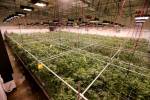Marijuana has potential to become Nevada’s biggest cash crop
Marijuana could become one of the biggest cash crops in Nevada when cultivation facilities open in the coming months, a UNLV soil and water scientist said.
“They’re going to make a lot of money using very little amount of water,” professor Dale Devitt said. “That’s how you justify the use of water in the desert.”
High-grade alfalfa grown on farms throughout Northern Nevada earns about $100 profit per acre-foot of water. Golf courses in Las Vegas make about $5,000 to $7,000 per acre-foot of water.
Devitt expects pot to dwarf those figures.
Marijuana is considered a drought-tolerant plant and doesn’t require a significant amount of water to grow, said Derek Peterson, president of Terra Tech, an agricultural company that’s applied for a marijuana cultivation license in Clark County. Terra Tech wants to open a 50,000-square-foot cultivation warehouse under a Las Vegas-based subsidiary called MediFarm LLC.
Early next month, Clark County commissioners will decide which of the 109 companies vying for medical marijuana licenses should be reviewed by the state Public and Behavioral Health Division. State approval would be provisional, and the county would decide whether to award business licenses.
If licensed, Peterson’s company would grow marijuana using hydroponics, widely considered the most environmentally friendly method of plant watering. In hydroponics, the plant absorbs only the water it needs and water is constantly recycled through the system. There’s no runoff and the only water lost is through evaporation.
Terra Tech has built cultivation facilities for marijuana companies in Colorado, Michigan, Washington and Massachusetts.
HARVESTING ALL YEAR LONG
Marijuana requires about 900 gallons of water per acre daily, Peterson said, and three-fourths of an acre of plants could be stuffed inside a 50,000-square-foot warehouse.
That means MediFarm could use up to 330,000 gallons of water a year, nearly four times as much as the use in the average single-family home.
Still, Southern Nevada Water Authority officials say they don’t have a strong grasp on how growing weed will affect water conservation in Clark County.
“This would be an opportunity for us to expand our knowledge of indoor agriculture,” water authority spokesman Bronson Mack said.
Water authority officials have “no real hard data” to determine how much water will be used growing pot in the desert, but they have spoken with experts in Colorado to help better gauge potential demand, Mack said.
Peterson expects to produce up to 75 pounds of marijuana weekly, which could yield $15 million to $25 million in sales. But production costs at the warehouse would equate to about 35 percent of the sales — more than $8.7 million annually, or around $730,000 a month — at a facility selling the most pot.
The average lease rate for industrial space in Las Vegas is about 54 cents per square foot, said Brian Gordon, a principal with the research group Applied Analysis.
Electricity accounts for about 10 percent of the production costs. Peterson said he would use 70 percent to 80 percent less energy in a greenhouse, but state law restricts pot growers to warehouses.
“Anytime you talk about water consumption, you have to talk about electricity,” Devitt said. “That’s the majority of cost associated with moving water.”
Controlled environment agriculture, as indoor growth is known, lets farmers harvest pot all year long.
“You’re not stuck with producing plants according to the season,” Peterson said. “So you have the ability to have multiple cycles of production throughout the year.”
Marijuana could be grown using treated wastewater to cut costs, but experts said that’s unlikely because of how little water it takes to bring pot to the market.
“You could manage almost any crop successfully with poor-quality waters if you know what you’re doing based on science,” Devitt said. “But the reality is the profit margin would be so significant that (farmers) would opt to just use potable water and pay the price.”
GREATER POTENTIAL IN NORTHERN NEVADA?
Farmers will have to learn to master harvesting large swaths of marijuana.
“Having good, quality water would minimize the potential negative impact as to the growth of the plant,” Devitt said.
Even a 50,000-square-foot warehouse is minimal when compared with farms that cover hundreds of acres in Northern Nevada.
“Clearly, water is a precious resource here in Southern Nevada. We’d be concerned about using it in any form,” Devitt said. “If we’re to become the medical marijuana center of the United States and have hundreds of greenhouses, that might become an issue, but right now we’re talking about small operations.”
State law allows for dispensaries and production facilities to buy from cultivation plants anywhere within the borders. But Clark County commissioners said any pot sold in the county must be grown in the county.
Devitt said marijuana would ideally be grown in a more conducive environment outside the state.
“At some point down the road, Las Vegas probably isn’t the best place to be growing these plants,” he said.
State Sen. Tick Segerblom, D-Las Vegas, who authored the bill that allowed pot businesses, said he wants to see marijuana grown as efficiently as possible, “given our water shortage and the fact that we have so much sun.”
That could also mean having marijuana grown in more rural northern counties and shipped to Southern Nevada.
“In the early stages, it’s not going to be that big of a deal,” Segerblom said. “And over time those things will sort themselves out.
“As we go forward, we want to minimize electricity and minimize the water usage.”
Contact reporter David Ferrara at 702-387-5290 or dferrara@reviewjournal.com. Follow @randompoker. on Twitter.




























